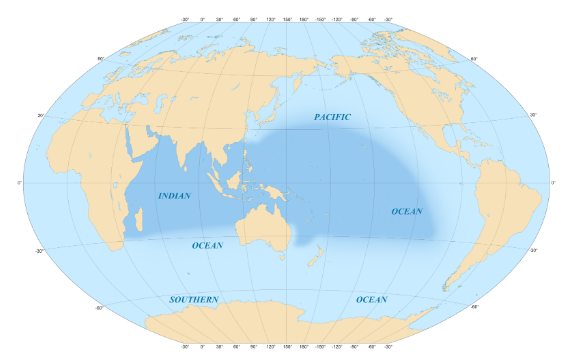Context:
In mid-July, 2023, the 56th Foreign Ministers Meeting (FMM) of the Association of Southeast Asian Nations (ASEAN) was held in Jakarta, Indonesia.
About Indo-Pacific:
- It is a new concept that has become increasingly influential.
- It includes the regions between the Pacific and Indian Oceans in Southeast Asia and includes four continents: Asia, Africa, Australia and America.
- This symbolizes the strategic regional comprehensive economic partnership between India and the United States.
- This region is one of the most populous and economically active regions of the world, comprising 60% of the world’s population and 2/3rd of the global economic output.
 Image Credits: Wikipedia
Image Credits: Wikipedia
About ASEAN:
- It is a regional organization established to promote political and social stability amid rising tensions among the Asia-Pacific’s post-colonial states.
- It was established on 8 August 1967 in Bangkok, Thailand, with the signing of the ASEAN Declaration (Bangkok Declaration).
- ASEAN Summit: It is the highest policy-making body in ASEAN comprising the Heads of States or Governments of ASEAN Member States, which is held twice annually.
- The First ASEAN Summit was held in Bali, Indonesia in 1976.
- Member Countries:
- Founding Members:
- Indonesia, Malaysia, Philippines, Singapore and Thailand.
- Further Entry of Members:
- Brunei Darussalam joined ASEAN on 7 January 1984
- Vietnam on 28 July 1995
- Lao PDR and Myanmar on 23 July 1997
- Cambodia on 30 April 1999
Significance of ASEAN for India:
- India shares a deep connection with ASEAN and has continued its active engagement in many areas contributing to regional peace and stability, particularly through ASEAN led mechanisms.
- ASEAN-led Mechanisms:
- East Asia Summit:
- It is the Indo-Pacific’s premier forum for strategic dialogue.
- It is the only leader-led forum at which all key Indo-Pacific partners meet to discuss political, security and economic challenges facing the region, and it has an important role to play in advancing closer regional cooperation.
- Member Countries: It includes ten ASEAN countries (Brunei, Cambodia, Indonesia, Laos, Malaysia, Myanmar, the Philippines, Singapore, Thailand, Vietnam) along with Australia, China, India, Japan, New Zealand, the Republic of Korea, Russia and the United States.
- India is one of the founding members of the East Asia Summit.
- ASEAN Regional Forum:
- It was launched in 1993 to facilitate cooperation on political and security issues to contribute to regional confidence-building and preventive diplomacy.
- ASEAN Defence Ministers Meeting (ADMM-Plus):
- It is an annual meeting of Defence Ministers of 10 ASEAN (Association of Southeast Asian Nations) countries and eight dialogue partner countries – Australia, China, India, Japan, New Zealand, Republic of Korea, Russia and the United States.
- The India-ASEAN strategic partnership has been strengthened by virtue of flourishing cultural and civilisational links and enhanced people-to-people cooperation.
- Delhi Dialogue: It was first held in 2009.
- It has emerged as an important forum at which political leaders, policy makers, researchers, academicians, business leaders and media persons converge for brainstorming on a range of issues pertaining to ASEAN-India relations.
- Plan of Action 2021-2025: It was adopted in 2020.
- It envisages greater cooperation in areas ranging from trade to maritime security and counter-terrorism.
Focusing Areas of the FMM:
- This FMM is indicating ASEAN’s brave attempts for transformative changes. It includes:
- The impact of the COVID-19 pandemic
- Economic slowdown
- The Ukraine war
- Climate change
- The Cold War-type confrontation between the United States and China
Vision of the FMM:
- Creating a political community that ensures regional peace and a just environment.
- Democratic and harmonious environment.
- An economic community focused on achieving a well-integrated and connected regional economy within the global economic system.
- A socio-cultural community to enhance the quality of life of ASEAN’s citizens as well as sustainable development of the region
Concerning Factors:
- Missing of Targets: Lacking achievement of goals.
- Enhancing Internal Differences: Their internal differences on issues such as Myanmar keep surfacing in public.
- International Factors: Its desire to lead the region and shape its agenda is under the risk of the strained relationship between the U.S. and China.
- Influence of China: China enjoys close political and economic relations with the ASEAN states and hence none of them raises its voice against China’s delaying tactics in negotiating an enforceable code of conduct concerning the South China Sea.
ASEAN Outlook on the Indo-Pacific (AOIP):
- ASEAN prefers to promote the ASEAN Outlook on the Indo-Pacific (AOIP).
- Identified Areas: Its four identified areas are:
- Maritime cooperation
- Connectivity
- UN Sustainable Development Goals 2030
- Economic cooperation
- Challenges:
- Implementation: Despite ASEAN partners reaffirming support for the AOIP, its actual implementation remains a worry.
- Lack of Unity: ASEAN reiterated its centrality, but it appears vulnerable when the grouping is unable to forge unity.
- Losing of Credibility: Without unity, ASEAN centrality loses much of its credibility.
- Example: Thailand is defying ASEAN’s official policy but running its own dialogue with the military government.
Way Forward:
- Implementation should be the Priority: ASEAN-led mechanisms should work in a dedicated and collaborative manner to gain fruitful implementations.
- Continuous & Friendly Engagement: Bilateral and Multilateral engagements among the ASEAN members should increase.
- Unity is a Must: ASEAN countries need to work to restore the ‘ASEAN centrality and unity’ through the strategic environment of competing interests.
- Reconciliation is a Need: Collaborative Steps should be taken for the reconciliation between Myanmar and the ASEAN.
- Tackle Emerging Challenges: Steps should be taken to tackle emerging challenges to international peace and security.
- Newer Areas of Cooperation to Cooperate: There are newer areas of cooperation where member countries should collaborate such as cyber, financial and maritime security domains.
News Source: The Hindu
![]() 25 Jul 2023
25 Jul 2023
 Image Credits: Wikipedia
Image Credits: Wikipedia